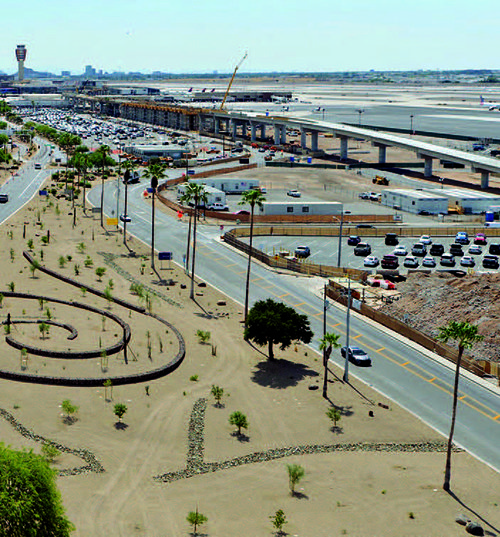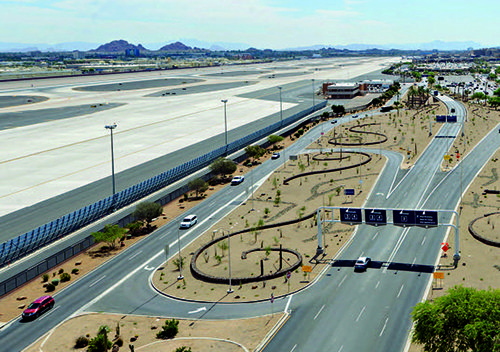Over the last two years, Phoenix Sky Harbor International Airport (PHX) has transformed its lush green landscape into an eye-catching desert environment that requires less water and reflects the region’s natural beauty. The move from grass and deciduous shrubs to rocks and native flora is expected to reduce the Arizona airport’s annual water usage by 5.375 million gallons and save about $425,000 per year.
 Over the last two years, Phoenix Sky Harbor International Airport (PHX) has transformed its lush green landscape into an eye-catching desert environment that requires less water and reflects the region’s natural beauty.
Over the last two years, Phoenix Sky Harbor International Airport (PHX) has transformed its lush green landscape into an eye-catching desert environment that requires less water and reflects the region’s natural beauty.
The move from grass and deciduous shrubs to rocks and native flora is expected to reduce the Arizona airport’s annual water usage by 5.375 million gallons and save about $425,000 per year. The $5 million project, which was completed in June, transformed 11 acres and updated 30 more.
“A project like turf replacement conveys the image and identity of Phoenix Sky Harbor and serves as a major step forward in our ongoing sustainability efforts,” explains James E. Bennett, the airport’s director of Aviation Services. “We have grown by leaps and bounds in recent years and continue to add great customer amenities; but we are also committed to being true to what makes us unique while ensuring we are sensitive to our environment.”
|
Project: Native Landscaping Location: Phoenix Sky Harbor Int’l Strategy: Replacing turf with native flora that require less water & reflect local desert environment Cost: $5 million (self-funded) Associated Water Savings: 5.375 million gallons/yr. Associated Cost Savings: $425,000/yr. Timeline: 2 years; completed in June 2019 Plantings: 435 trees that require little water; 75 saguaro cacti; 275 large cacti (ocotillo, senita, totem pole, organ pipe, etc.); 2,900 accent plants & shrubs for groundcover Design/Construction: J2 Engineering & Environmental Design LLC Smart Controls for Water Management: Calsense Noteworthy Features: Extensive use of cacti & native plants; rain gardens that collect & reuse rainwater for irrigation; rock-filled gabion baskets arranged to look like wingtip vortices when viewed from the air |
The method used, known as xeriscaping, incorporates native plants to conserve water and leverages other sustainable strategies. In fact, the entire project was inspired by the airport’s 2015 Sustainability Management Plan, which includes a goal of reducing water consumption 10% throughout its grounds and facilities by 2020.
Jennifer Maples, superintendent of aviation facilities, notes that the project had been discussed for many years. “We had beautiful grass; it was gorgeous,” she reflects. “But it came with a price tag. We realized having that type of landscaping was probably not the most responsible thing to do.”
After personnel quantified the benefits of switching to native landscaping, Maples issued a funding request in 2016. “We pitched the idea to airport leadership and demonstrated the quick payback through cost savings via water conservation and reduced maintenance requirements.”
Underground Surprises
J2 Engineering and Environmental Design, LLC, the Phoenix firm that designed the new landscape scheme and oversaw construction, which began by removing the existing turf, plantings and underground irrigation system that was previously needed to maintain them. Because the area involved was located on the older side of the airport property, there were some surprises.
“We found water, sewer and communication lines that were buried but never marked or identified,” relates J2 Vice President Jeff Engelmann. “It was a fact-finding mission to determine whether the lines were still viable; and then we had to redesign some parts of the project to adapt to these discovered facilities.”

J2’s design includes extensive grading throughout the area to create a multi-level landscape. Height was added by earthen berms covered with indigenous rock; other areas were lowered to create rain gardens, which help capture rainwater to provide the surrounding vegetation with a natural source of irrigation. “The new earthwork reinforced the overall theme that we developed for the project: a Sonoran Desert landscape,” says Engelmann.
The airport worked collaboratively with the FAA regarding airfield safety—specifically, height restrictions for trees, and selecting plants that do not attract wildlife. In addition to choosing varieties from the FAA-approved list, the airport and J2 opted for plants that require little water and provide visual variety. “We took special care to populate areas with enough different species so there is a variety of colors of flowers and foliage, with different flowering cycles so there is always something in bloom,” explains Engelmann.
In total, the airport added 435 new trees, 75 saguaro cacti, 275 large cacti (ocotillo, senita, totem pole, organ pipe, etc.) and about 2,900 accent plants and shrubs for groundcover. Fully 61 of the 75 saguaros were transplanted from other areas of the airport.

“The project has a very diverse plant legend,” says Seth Placko, a landscape architect with J2. “The airport didn’t want the whole palette to be just the same 10 plants; they wanted a lot of variety for better aesthetics.”
Conserving Water
In addition to changing its landscape strategy, PHX also took the opportunity to begin transitioning to a high-tech point source drip irrigation system that is also used in many of the city’s parks and preserves.
“We put everything on the Calsense resource management system controller, which monitors the environment and only applies water when needed,” Engelmann explains. “The controllers read humidity and temperature, then calculate evaporation and automatically adjust water times for plants based upon all that information. In addition, if there happens to be an irrigation leak, the system is smart enough to shut down specific areas of the system and send a signal to Sky Harbor staff notifying them that there is a problem and where that problem is located; and that saves water, too.”
Placko highlights the importance of the system’s leak detection feature. “Water is very precious to us,” he emphasizes. “If there is a break in the middle of the night, you lose water and you don’t get to use it again. This project has an overall desert-sensitive approach.”
Natural Design
From the ground, PHX’s new landscape resembles a typical Sonoran Desert. But views from the air bring an entirely different perspective. A string of gabion baskets snakes throughout the property for nearly 9,000 linear feet to mimic the swirling vortices created by wingtips of high-speed jets.
The airport opted for the baskets as a hardscape to visually break up the areas that would otherwise be dominated by decomposed granite. They range in height up to 16 inches tall, and are filled with fractured, angular rocks from a nearby quarry—another use of indigenous materials.
“We presented the idea of the vortices to the airport,” says Engelmann. “We wanted to recreate that pattern on the ground. The gabion baskets allowed us to do that as well as shape the earth to reinforce the idea of air movement.”
The rock-filled baskets are made of non-galvanized metal, which allows rust for a natural effect. “We wanted it to look weathered, so the metal blends with the colors in the rocks,” explains Placko.

While the gabion baskets have a structured layout, the airport wanted placement of the plants to be intentionally unstructured. “A natural desert landscape will not manifest itself in grids or rows, so we wanted our landscape to be organic and reflective of the natural beauty found in the Sonoran Desert,” explains Maples.
 In addition to creating the new 11-acre desert landscape, PHX also updated 30 acres of existing xeriscaped areas. “We have a focus and commitment on water conservation,” says Maples. “In the desert environment, we get 8 inches of rain a year on average. Conserving water through appropriate landscape was one way we could achieve sustainability at the airport.”
In addition to creating the new 11-acre desert landscape, PHX also updated 30 acres of existing xeriscaped areas. “We have a focus and commitment on water conservation,” says Maples. “In the desert environment, we get 8 inches of rain a year on average. Conserving water through appropriate landscape was one way we could achieve sustainability at the airport.”
On average, the airport uses 25 million gallons of water a month. The anticipated $425,000 annual savings from recent landscaping changes will not only come from less water usage but also from eliminated wages. Because the new design requires less maintenance, three employees (a groundskeeper, forestry technician and gardener) were not replaced after they vacated their positions for retirement and other opportunities.
In retrospect, J2’s Engelmann says the project reached its goal: to have PHX reflect the community. “Sky Harbor now blends in better with the Sonoran Desert,” he says. “The water savings is certainly large, but I also think now we have an airport that really does a nice handshake with the environment in which it lives.”
Airport officials are also pleased with the results. “We have paid respect to our roots and simultaneously strengthened our sustainability,” says Bennett. “That is an investment in our future.”


 facts&figures
facts&figures

